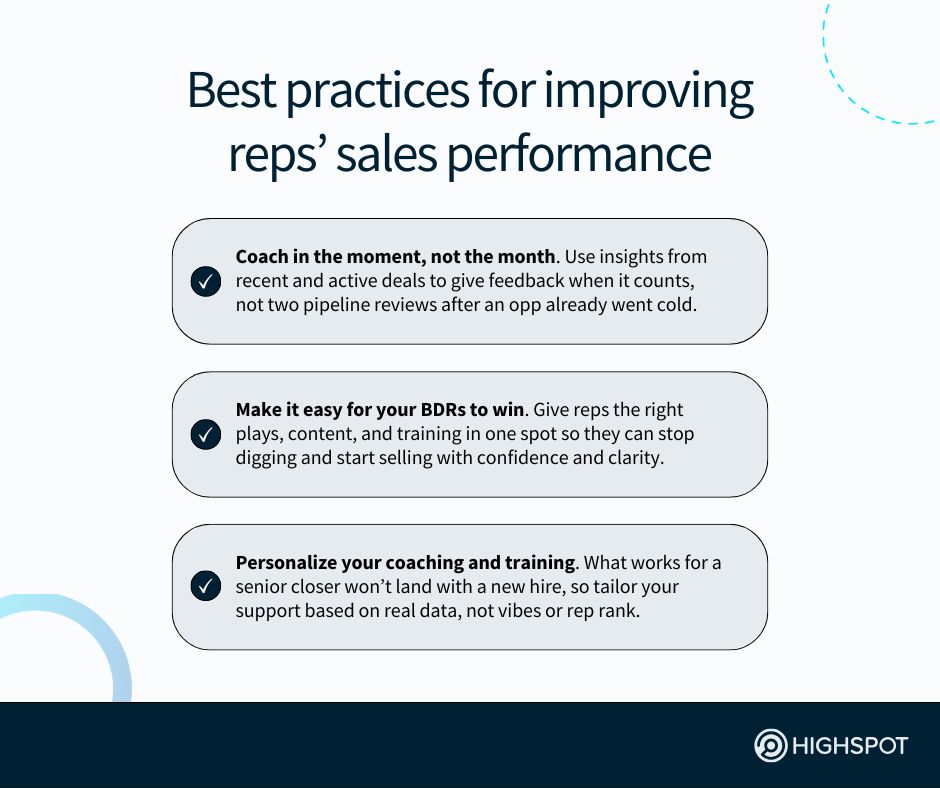Key Takeaways
- Discovering how to improve sales performance requires go-to-market (GTM) leaders to connect strategy to execution with clear guidance, training, and real-time insights that help reps act with confidence.
- Driving consistent results depends on ongoing sales performance management by managers and revenue operations using daily metrics to spot gaps, coach smarter, and align teams.
- Sales managers must use performance data to coach each rep in context, while ensuring everyone in their sales organisation consistently executes the strategy that drives pipeline and revenue.
Sales teams today are working harder than ever. This issue is that effort alone doesn’t drive revenue, and, without the right approach, the gap between activity and impact only widens. It’s why go-to-market leaders across industries are urgently rethinking their strategy to drive sustainable performance.
Knowing how to improve sales performance requires more than just intuition or hustle. It also takes insight, consistency, and systems that help your team learn winning selling behaviours and show up smarter in buyer conversations.
- Too often, reps are overloaded with content, playbooks, and siloed tools that don’t align with their daily workflows. This creates confusion instead of clarity.
- What’s worse, promising deals stall, messaging falls flat, and sellers lose momentum when it matters most, undermining even the strongest GTM strategies.
- It’s frustrating for BDRs, but it’s also costly for your business at large. These factors ultimately negatively affect sales performance and can drag down growth across your entire pipeline, leading to missed quotas and revenue targets.
To turn that around, you need to strengthen your sales team’s performance through a unified strategy that aligns your people—enablement, sales, and marketing—with proven processes and platforms so they can see what helps and hinders their customer relationship management efforts and course-correct accordingly.

What is sales performance?
Sales performance refers to how effectively your reps convert opportunities into revenue, tracking both individual contribution and broader team execution. It reflects how well BDRs execute your sales strategy in the field and how consistently they meet or exceed key metrics tied to pipeline, win rate, and quota.
A strong sales performance management strategy gives teams the structure and tools to build skills, take action with confidence, and adjust in real-time.
Using sales performance dashboards featuring a blend of data from their CRM system, enablement platform, and other GTM tools, managers can quickly identify what’s working, what’s stalling, and where to double down for better results.
When supported by leading sales performance management software that enables go-to-market leaders to better equip, guide, coach, and train their sellers, reps can spend more time engaging qualified leads and closing deals and less time on labour-intensive busywork and manual admin tasks.
That clarity empowers enablement and marketing teams to deliver smarter programmes, aligned content, and better support across the B2B buyer’s journey.
| FAQ on how to improve sales performance | Answer |
|---|---|
| What is the best way to measure sales performance for my team of reps today? | Use a centralised dashboard that connects rep activity, skill growth, and buyer engagement so you can benchmark against top performers and take targeted action based on what’s driving real pipeline momentum across the team. |
| How do I link sales performance metrics and KPIs directly to business results? | Map sales team KPIs to GTM initiatives like product launches or cross-sell plays, then track how seller actions—such as content shared, training completed, conversations held—impact pipeline, conversion, and revenue using connected analytics. |
| How can I use buyer engagement data to improve my sales reps’ performance? | Measure which enablement content and touchpoints drive the most buyer action, then surface that data to reps in real-time so they can tailor outreach, improve follow-ups, and double down on what’s actually resonating with your target audience. |
| What changes should I make when reps miss monthly sales targets and quotas? | Start by identifying where reps fall short in terms of activity, messaging, and skills, then reinforce the right behaviours through targeted coaching, refreshed plays, and personalised training paths that can address critical go-to-market performance gaps. |
| How do I streamline sales performance management for inside and field sellers? | Use a unified sales enablement platform like Highspot that centralises training, plays, and analytics so every rep stays aligned no matter where or how they work, and managers can track, support, and optimise performance in a single, centralised system. |
| How should I address underperformance by sales development representatives? | Identify blockers in seller behaviour, skills, and messaging through data, then reinforce role-specific expectations with targeted rep training, manager feedback, and coaching workflows that help BDRs execute stronger across sales prospecting motions. |
| How can I use real-time sales performance data to better coach my reps? | Combine your CRM data, meeting insights, and training progress into one view so managers can proactively spot gaps, personalise support, and coach with precision based on how each seller is performing in live selling situations. |
| How can AI and automation tools increase sales performance for my teams? | Using AI-powered tools like Highspot can surface deal-specific insights, recommend top-performing content, and automate manual workflows. This helps reps stay focused, respond faster, and take smarter actions that increase their selling impact. |
| What sales technology should I use to improve my reps’ sales performance? | Go-to-market platforms like Highspot are built to unify content, coaching, training, and analytics so managers can guide every rep with in-the-moment actions and just-in-time guidance that improve execution, boost productivity, and drive revenue outcomes. |
What good sales performance looks like
Effective sales performance can look slightly different depending on the company, but at its core, it’s about sales representatives consistently hitting their targets.
Many believe that pipeline health is a strong indicator of performance. Having 3-4x your quota in the pipeline suggests ample opportunity to meet targets.
But if reps use the wrong sales techniques, that won’t translate into closed deals.
The top indicator of sales performance often boils down to how much time reps spend with buyers. High-performing reps usually dedicate more time to direct interaction with prospects—about an extra hour per week compared to their peers.
That may not sound like much, but it adds up to four more hours a month, making a sizable difference in achieving desired sales outcomes and revenue goals.
There are a few benchmarks to consider when tracking sales performance.
One example is the number of touches it takes to reach a prospect. On average, engaging a potential B2B buyer takes more than a dozen attempts. This stat epitomises how persistent today’s sales professionals need to be to succeed.
When tracking your team’s performance, a good benchmark for lead-to-opportunity conversion is around 30%. Remember, 70% of leads won’t go anywhere, which is normal. The goal is to ensure those 30% are well worth the effort.
Why measuring sales performance dashboard data daily is essential
If you’re only reviewing rep performance at the end of the quarter, you’re too late. Opportunities have already slipped. It’s cleanup mode, not coaching time.
Daily check-ins on sales performance management help you course-correct while there’s still time to save the deal, coach the moment, and boost momentum.
When you monitor sales performance metrics that reveal patterns in outreach, engagement, and conversions, you spot gaps before they become trendlines.
More importantly, tracking dashboards daily helps leaders like you ID optimal sales tactics that drive sales performance across teams and territories.
Keeping a close eye on dashboard data tied to new and existing customers and reps’ efforts to convert high-value accounts is vital because it enables you to:
- Spot deal-stalling behaviour, like how much time sales reps spend on admin instead of engaging potential customers in live sales conversations.
- See which sellers consistently exceed expectations and learn from each sales rep’s approach to scale winning selling behaviours across the team.
- Ensure everyone in your sales organisation is executing the plays, messaging, and follow-up timing that aligns with your sales strategies.
- Identify early signs of funnel friction across the sales funnel and alter your sales processes before small problems turn into missed quarters.
- Uncover how personalised customer interactions impact conversion rates and use that to coach smarter, sharper, more relevant outreach.
- Measure sales efficiency across teams with real-time data, not gut feel—and use those insights to drive overall sales performance long term.
With performance data and AI-powered GTM insights readily available to you and other go-to-market leaders, you’re not waiting for red flags. You’re reading the signs before they turn into alarms and making smarter decisions faster.
All sales reps benefit from this rhythm because it gives every manager real visibility into the habits, pacing, and pipeline health of their teams.
Even small insights, like one rep’s outreach spike or drop, can offer sales coaching gold, when tied to your sales process and contextualised in the data.
TL;DR: Dashboards aren’t just rep reporting tools. They’re decision engines that help you fine-tune your go-to-market strategies before deals disappear.
How to improve sales performance: 10 strategies for go-to-market leaders
There isn’t a single approach that will enhance sales performance across all organisations. However, once your goals, roles, technology, and GTM enablement strategies are in place, you can see significant improvements.
Here are 10 practical ways to boost your sales team’s performance:
1. Set SMART goals based on your sales metrics
Set SMART sales goals (Specific, Measurable, Achievable, Relevant, and Time-bound) for your team to give them a clear direction and a way to measure their success. This will allow reps to see their progress and understand exactly what is expected.
One SMART goal related to sales performance might be to increase sales quota attainment by 10% within the next quarter. This goal is:
- Specific: Focuses on quota attainment
- Measurable: It has a quantifiable target (10% increase)
- Achievable: Based on past performance, it’s within reach
- Relevant: Tied directly to sales performance
- Time-bound: It has a deadline of the next quarter
Once SMART goals are in place, tracking key performance indicators (KPIs) to monitor progress is important. This may include:
- Win rate: The percentage of deals closed compared to deals lost
- Sales pipeline coverage: The ratio of open opportunities to the sales quota
- Conversion rates: Tracks leads as they are archived or turn into customers
- Sales cycle length: Measures how long it takes to advance buyers and close deals
- Average deal size: Average value of your company’s sales transactions or deals
- Customer acquisition cost (CAC): What your business spends on a new customer
Tracking these sales performance metrics alongside your goals and forecasts provides a clear view of how reps are doing daily, weekly, monthly, or quarterly. For instance, if your win rate is low, you may need to provide more personalised training to your BDRs or adjust your lead qualification process.
Regularly reviewing objectives and monitoring sales performance data keeps your team on track while flagging improvement opportunities for each seller.
2. Optimise your sales strategy and team structure
A well-defined strategy aligns your sales efforts with your business goals. It clearly defines target markets, valuable selling points, and how to address customer needs.
For example, a strong sales strategy might focus on building relationships with complex teams of decision-makers while also leveraging AI and sales data to personalise messaging to each prospect based on their specific pain points.
Since you need to be agile and responsive to changing consumer needs, don’t shy away from examining your sales strategy bi-annually, quarterly, or even monthly.
Though this may seem intensive, it’s important to continuously confirm your sales plan is still relevant to the market you’re selling to.
A substantial part of your strategy is your sales organisation’s structure. It plays a huge role in how your team can perform. That’s because certain sales models are better suited to certain types of businesses, selling motions, or solutions.
It’s not uncommon for businesses to start with one structure and move to another as their company evolves, so take the time to evaluate the three most common sales models—the assembly line, the island, and the pod—and determine which one is right for your business.
3. Find the sales methodology that works for you
A robust sales methodology helps reps identify customer needs, provide tailored solutions, and continue to support customers after the sale.
Some popular methodologies include SPIN selling, which focuses on asking key questions to diagnose customer pain points, and Challenger Sales, which encourages reps to teach customers something new and challenge their existing approach.
It’s important to regularly evaluate whether your current sales methodology and ideal customer profile fit your business’s growth and market needs. As your company evolves, so should your approach to pitching your products and services.
As our team explains, each sales methodology brings a different lens to the selling experience—and choosing the right one can directly impact your team’s revenue, outcomes, and performance.
4. Ensure sales leaders routinely train and coach
Setting your reps up for success starts with implementing an effective sales onboarding process. This gives them the foundational knowledge, skills, and best practices they need to hit the ground running and accelerates their path to productivity so they can quickly become high-performing sales team members.
Ongoing sales training is just as important, as it helps BDRs adapt to ever-changing buyer expectations and ensure they stay ahead of industry trends.
Beyond training, providing constructive feedback and tailored sales coaching is crucial for nurturing seller talent and improving their sales performance.
You and other managers should regularly evaluate reps to pinpoint areas where they can refine their approach and celebrate their wins. This balance of growth and recognition motivates the team to push past obstacles and excel in their roles.
Sales enablement ties everything together, equipping sellers with the content, tools, and resources to do their jobs efficiently. It ensures they focus more on engaging customers instead of wasting time looking for answers, allowing them to be more strategic in their approach and create more meaningful interactions.
5. Only use content that impacts conversion rates
Sales content should help deals move, but even with the best intentions, managing, organising, and surfacing the right materials at the right time can be chaotic.
On average, sales reps use over 17 pieces of content throughout the sales process. They also spend 40% of their time searching for or creating content. This solution leads to off-brand, off-message, and outdated content, which affects the quality and effectiveness of sales interactions.
Centralising your sales content makes it easy for sales teams to instantly access the latest and most relevant information they need. With everything at their fingertips, sellers can approach buyers with confidence, armed with the right insights.
Regular audits further improve this process by helping you identify overlapping content or outdated materials that should be removed, keeping your library streamlined and effective. Sales enablement technology can help organise and manage content in one place within your team’s workflow.
6. Focus on improving customer satisfaction
A seamless and smooth customer experience, where engagement is effortless from the first contact to purchase and beyond, can boost sales performance and customer satisfaction. If your customers encounter delays, poor follow-ups, or clunky handoffs between teams, they’ll hesitate to buy from you again.
Elevating the entire customer experience requires not just sales and marketing alignment but also collaboration with customer success and other revenue-generating teams to deliver consistent, helpful interactions at every touchpoint.
A great way to stay connected with your existing customers is by creating a Customer Advisory Board, where they can provide feedback and insights to improve your products and services. Satisfied customers are your best advocates, often referring new business and making repeat purchases (or renewing).
Put another way? Customer feedback is your friend. Using insights from existing customers to discover what changes you can make to better engage and advise future buyers as they move from one customer journey stage to the next.
7. Choose incentives that help increase sales
Incentives should help drive sales behaviours that align with your sales goals.
This will not only enhance performance and retain top talent but also ensure your team focuses on initiatives that drive revenue growth and profitability.
Focus on rewarding sales activities that sell your high-priority products, break into new markets, or help retain customers. You should also be transparent with sales targets and offer meaningful incentive compensation plans for meeting quotas.
8. Invest in best-in-class sales technology
Technology and automation can be a huge asset for your sales team, but only when used wisely. Over a third of employees (37%) report using too many tools to use, according to recent Personio research. Meanwhile, another 36% state that working across different systems disrupts selling productivity.
To avoid this, adopt platforms that improve their day-to-day workflow, such as sales dashboards to better visualise and manage customer data, or AI-powered sales tools that help prioritise prospects or personalise interactions.
Ideally, your solutions can be integrated with one another to streamline your existing pipeline-generation processes: from lead generation to closing deals.
9. Use the right sales and marketing channels
You never know where your next prospect will come from, so take advantage of every sales channel available. This could mean email, text, phone, or social media, tapping into partner sales or attending niche industry events.
As you explore new channels, be sure to provide reps with training, content, and guidance on how to maximise each one. Customising messaging and content, as well as introducing specific sales plays will ensure your team’s pitches land effectively whenever and wherever your buyers encounter them.
Learn how the enablement team at SS&C Intralinks uses Highspot to equip, guide, coach, and train reps and help boost their sales performance.
10. Make every sales touchpoint personalised
Personalisation is key to buyer engagement, but it can be time-consuming for reps. How can you make it easier? Start by putting yourself in your sales reps’ shoes: with lots of content to share and little time to do it, reps need a simple solution to quickly personalise everything from emails to presentations.
Therefore, enablement teams should focus on preparing foundational content—such as a customer deck—with many pivots for different industries and personas, all in one master asset.
Adding templated emails and social content into your enablement solution is another great way to make the personalisation process simple for reps looking to quickly distribute thought leadership.
You can also leverage conversation intelligence. It uses artificial intelligence to tailor bespoke messaging, create real-time responses, and recommend relevant content based on buyer preferences and past interactions.
Additionally, digital sales rooms take personalisation to the next level by providing a curated, interactive digital space where buyers can access content and resources just for them, making sales presentations more engaging.




